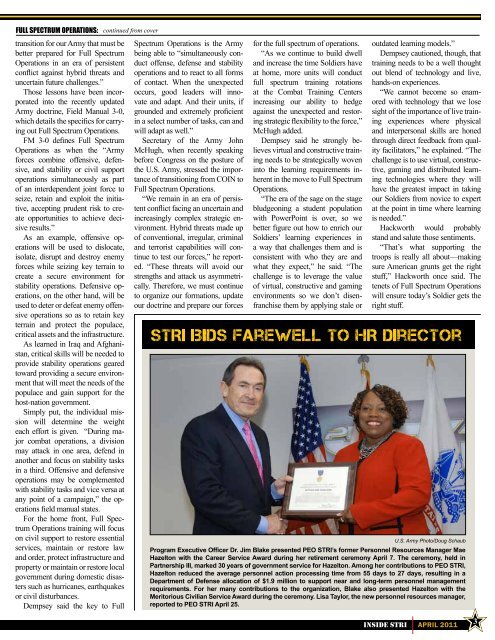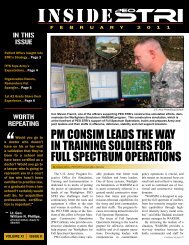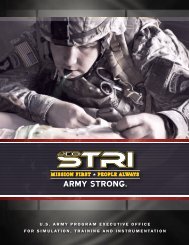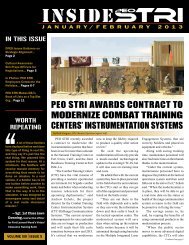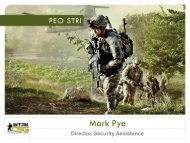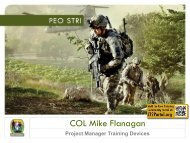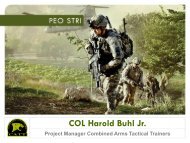InsIde - PEO STRI - U.S. Army
InsIde - PEO STRI - U.S. Army
InsIde - PEO STRI - U.S. Army
You also want an ePaper? Increase the reach of your titles
YUMPU automatically turns print PDFs into web optimized ePapers that Google loves.
Full Spectrum Operations: continued from cover<br />
transition for our <strong>Army</strong> that must be<br />
better prepared for Full Spectrum<br />
Operations in an era of persistent<br />
conflict against hybrid threats and<br />
uncertain future challenges.”<br />
Those lessons have been incorporated<br />
into the recently updated<br />
<strong>Army</strong> doctrine, Field Manual 3-0,<br />
which details the specifics for carrying<br />
out Full Spectrum Operations.<br />
FM 3-0 defines Full Spectrum<br />
Operations as when the “<strong>Army</strong><br />
forces combine offensive, defensive,<br />
and stability or civil support<br />
operations simultaneously as part<br />
of an interdependent joint force to<br />
seize, retain and exploit the initiative,<br />
accepting prudent risk to create<br />
opportunities to achieve decisive<br />
results.”<br />
As an example, offensive operations<br />
will be used to dislocate,<br />
isolate, disrupt and destroy enemy<br />
forces while seizing key terrain to<br />
create a secure environment for<br />
stability operations. Defensive operations,<br />
on the other hand, will be<br />
used to deter or defeat enemy offensive<br />
operations so as to retain key<br />
terrain and protect the populace,<br />
critical assets and the infrastructure.<br />
As learned in Iraq and Afghanistan,<br />
critical skills will be needed to<br />
provide stability operations geared<br />
toward providing a secure environment<br />
that will meet the needs of the<br />
populace and gain support for the<br />
host-nation government.<br />
Simply put, the individual mission<br />
will determine the weight<br />
each effort is given. “During major<br />
combat operations, a division<br />
may attack in one area, defend in<br />
another and focus on stability tasks<br />
in a third. Offensive and defensive<br />
operations may be complemented<br />
with stability tasks and vice versa at<br />
any point of a campaign,” the operations<br />
field manual states.<br />
For the home front, Full Spectrum<br />
Operations training will focus<br />
on civil support to restore essential<br />
services, maintain or restore law<br />
and order, protect infrastructure and<br />
property or maintain or restore local<br />
government during domestic disasters<br />
such as hurricanes, earthquakes<br />
or civil disturbances.<br />
Dempsey said the key to Full<br />
Spectrum Operations is the <strong>Army</strong><br />
being able to “simultaneously conduct<br />
offense, defense and stability<br />
operations and to react to all forms<br />
of contact. When the unexpected<br />
occurs, good leaders will innovate<br />
and adapt. And their units, if<br />
grounded and extremely proficient<br />
in a select number of tasks, can and<br />
will adapt as well.”<br />
Secretary of the <strong>Army</strong> John<br />
McHugh, when recently speaking<br />
before Congress on the posture of<br />
the U.S. <strong>Army</strong>, stressed the importance<br />
of transitioning from COIN to<br />
Full Spectrum Operations.<br />
“We remain in an era of persistent<br />
conflict facing an uncertain and<br />
increasingly complex strategic environment.<br />
Hybrid threats made up<br />
of conventional, irregular, criminal<br />
and terrorist capabilities will continue<br />
to test our forces,” he reported.<br />
“These threats will avoid our<br />
strengths and attack us asymmetrically.<br />
Therefore, we must continue<br />
to organize our formations, update<br />
our doctrine and prepare our forces<br />
for the full spectrum of operations.<br />
“As we continue to build dwell<br />
and increase the time Soldiers have<br />
at home, more units will conduct<br />
full spectrum training rotations<br />
at the Combat Training Centers<br />
increasing our ability to hedge<br />
against the unexpected and restoring<br />
strategic flexibility to the force,”<br />
McHugh added.<br />
Dempsey said he strongly believes<br />
virtual and constructive training<br />
needs to be strategically woven<br />
into the learning requirements inherent<br />
in the move to Full Spectrum<br />
Operations.<br />
“The era of the sage on the stage<br />
bludgeoning a student population<br />
with PowerPoint is over, so we<br />
better figure out how to enrich our<br />
Soldiers’ learning experiences in<br />
a way that challenges them and is<br />
consistent with who they are and<br />
what they expect,” he said. “The<br />
challenge is to leverage the value<br />
of virtual, constructive and gaming<br />
environments so we don’t disenfranchise<br />
them by applying stale or<br />
outdated learning models.”<br />
Dempsey cautioned, though, that<br />
training needs to be a well thought<br />
out blend of technology and live,<br />
hands-on experiences.<br />
“We cannot become so enamored<br />
with technology that we lose<br />
sight of the importance of live training<br />
experiences where physical<br />
and interpersonal skills are honed<br />
through direct feedback from quality<br />
facilitators,” he explained. “The<br />
challenge is to use virtual, constructive,<br />
gaming and distributed learning<br />
technologies where they will<br />
have the greatest impact in taking<br />
our Soldiers from novice to expert<br />
at the point in time where learning<br />
is needed.”<br />
Hackworth would probably<br />
stand and salute those sentiments.<br />
“That’s what supporting the<br />
troops is really all about—making<br />
sure American grunts get the right<br />
stuff,” Hackworth once said. The<br />
tenets of Full Spectrum Operations<br />
will ensure today’s Soldier gets the<br />
right stuff.<br />
<strong>STRI</strong> IBIds Farewell to HR Director<br />
U.S. <strong>Army</strong> Photo/Doug Schaub<br />
Program Executive Officer Dr. Jim Blake presented <strong>PEO</strong> <strong>STRI</strong>’s former Personnel Resources Manager Mae<br />
Hazelton with the Career Service Award during her retirement ceremony April 7. The ceremony, held in<br />
Partnership III, marked 30 years of government service for Hazelton. Among her contributions to <strong>PEO</strong> <strong>STRI</strong>,<br />
Hazelton reduced the average personnel action processing time from 55 days to 27 days, resulting in a<br />
Department of Defense allocation of $1.9 million to support near and long-term personnel management<br />
requirements. For her many contributions to the organization, Blake also presented Hazelton with the<br />
Meritorious Civilian Service Award during the ceremony. Lisa Taylor, the new personnel resources manager,<br />
reported to <strong>PEO</strong> <strong>STRI</strong> April 25.<br />
Inside <strong>STRI</strong> april 2011<br />
3


